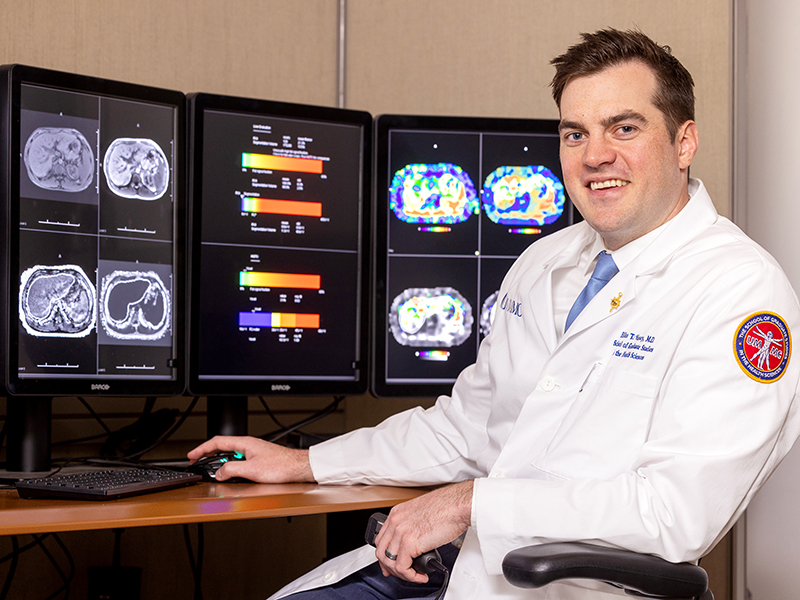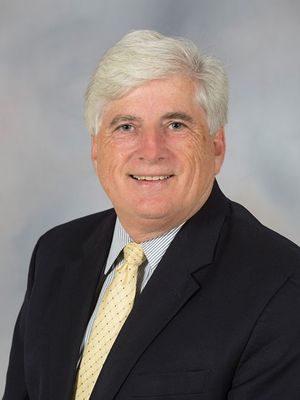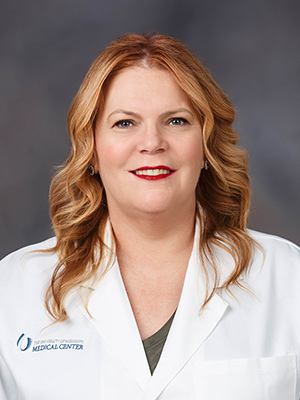Front and Center: Dr. Elliot Varney

When Dr. Elliot Varney earns his doctorate in biomedical imaging in May, he will become the first student to graduate from a University of Mississippi Medical Center combined residency and Ph.D. program.
But he’s not done yet. Because the Residency-Ph.D. track adds time to a traditional residency, Varney still must complete two years of diagnostic radiology residency, followed by one-to-two years in interventional radiology.
But why would a newly licensed MD, starting a residency, want to pursue a Ph.D.? The answer: passion. As much as he loves radiology, he’s equally enamored with research, and wanted to marry the two.
“Being a physician in my mind is much more than treating patients each day. It is reading and understanding the medical literature and staying up to date on advances within the field. Research training teaches you how to do that the most effectively in my opinion.”
The diagnostic radiology chief resident, who earned his medical degree from UMMC and bachelor’s in biochemistry from Millsaps College, believes his research training will make him a better physician.
“The medical community should never be content with the current options and treatments we have to offer patients,” said the fourth-year resident. “There are so many technologies, treatments and interventions that would benefit from improvement.
“Innovation is medicine, and challenging the status quo is essential to improving the care of our patients. The real reason I do research and pursued this program was to hopefully do just that.”
Varney’s dissertation focuses on finding new ways of assessing obesity and obesity-related disease with the use of CT and MRI scans, with an emphasis on body composition and fatty liver disease.

“The quality of his dissertation research is exemplified by the awards he’s received from regional and national scientific societies,” said Dr. Joey Granger, associate vice chancellor for research and dean of the School of Graduate Studies in the Health Sciences. “The Residency Ph.D. program is a unique training program within the SGSHS and is an important component of our clinician-scientist pipeline program.”
After completing his residencies, Varney wants to begin his career as a physician-scientist focusing on health disparities, especially as they relate to subspecialty cancer care in interventional radiology.
Further down the road, he hopes to maintain an active role in research and education by teaching students and residents while actively participating in and serving as principal investigator of clinical trials. Ultimately, he wants to chair an academic radiology department or serve in an administrative role related to advancing institutional research initiatives.

The program is the only active one in the nation that offers a combined residency in radiology and graduate doctoral work, said Dr. Candace Howard, associate professor and graduate track director of biomedical imaging, vice chair and director of radiology research, director of imaging for translational research and chief of cardiac and body imaging.
“This is a creative, out-of-the-box program meant to cultivate and retain our own physician-scientists and set them up on a path of success within their chosen field of medicine without the gaps in training and research projects inherent to traditional MD-Ph.D. programs,” said Howard, its founder.
Varney was the ideal initial candidate, said Howard, his mentor.
“His outstanding work ethic, keen analytical mind and unmatched enthusiasm for research and medicine ensured that he would be able to handle the rigors of completing graduate course work and his clinical radiology residency training in concert.
“Elliot has exceeded all expectations. His clinical training has not been diminished by his research but has been enhanced. He was chosen by his peers and faculty to be chief resident, has been one of the DXIT [Diagnostic Radiology In-Training Exam that residents take each year] top performers in the nation and won the Rising Scholar award each year of his residency.”
The accolades don’t stop there. Varney has already published 12 peer-reviewed articles, with another nine under various stages of review. And barely three months into 2023, he’s already garnered seven awards this year, including a dissertation fellowship, scholarship, radiology research awards, and two oral presentation awards -- one for first place and one “Outstanding.”
His most recent, the American Roentgen Ray Society Resident/Fellow in Radiology Award received in late February, was particularly humbling.
“It is one of my most coveted awards I have received to date,” said Varney. “Not only am I extremely honored that my dissertation work is being recognized by an international society, but it also provides a sense of validation for my efforts throughout my time as a graduate student and resident. It validates the exact reason why I chose this path. I am extremely grateful.”
The biomedical imaging Ph.D. track is designed for highly qualified students interested in how science relates to applications of image analysis and biotechnology in biomedical research, said Granger.
“Dr. Varney’s performance in this program has been exceptional and sets a high standard for future candidates,” said Granger. “We look forward to him joining UMMC’s growing clinician-scientist research team when he completes his clinical training.”
Varney, who lives in Madison with his wife and son, almost 2, admits the workload has been challenging.
“It has been much more difficult than I expected,” he said. “The time required to work clinical duties full-time through the day -- at times through the night -- and finding time after hours to continue progress on research and continue growing my clinical knowledge was the most challenging part.
“My top priority beyond completing the program was to never jeopardize my clinical training or clinical skills. This thought process definitely made it more difficult, but I do believe served me well in the end.”
Read more Front and Center stories online. Do you know a student, staff, volunteer or faculty member at the University of Mississippi Medical Center whose story would make an interesting feature or deserves to be recognized? Think about someone with outstanding job commitment, fascinating hobby or amazing accomplishment.
To nominate someone to be considered for a Front and Center feature, just complete and submit this short form. If that person is picked for a feature, a member of the Communications and Marketing staff will contact him or her to learn more about his or her personal story.


